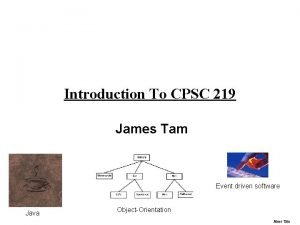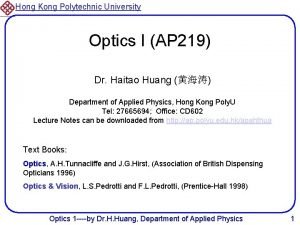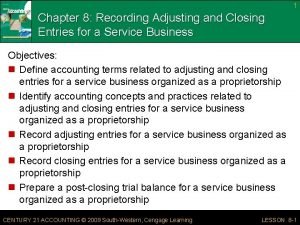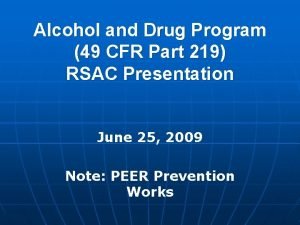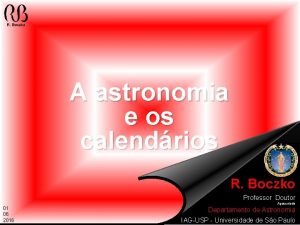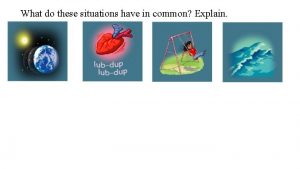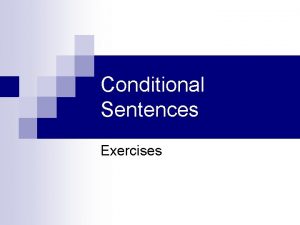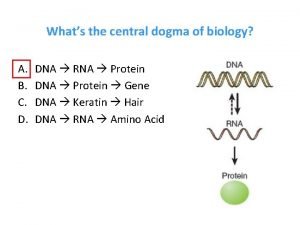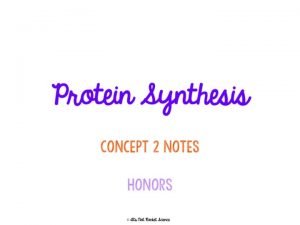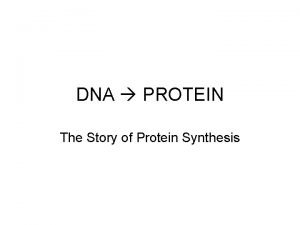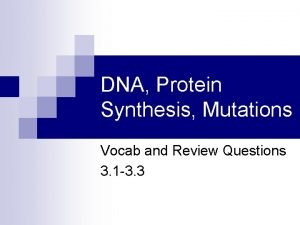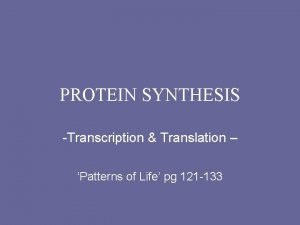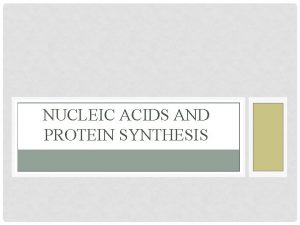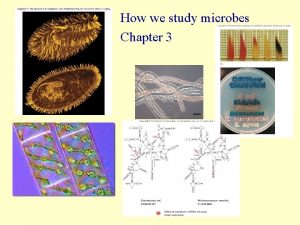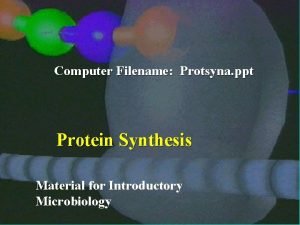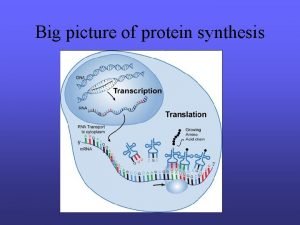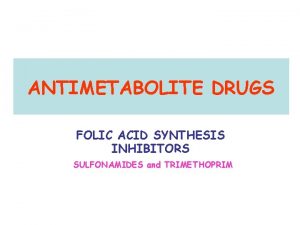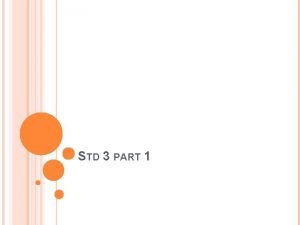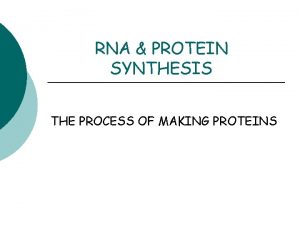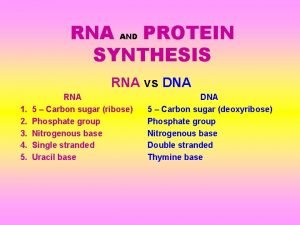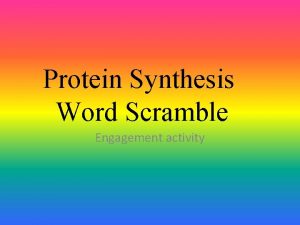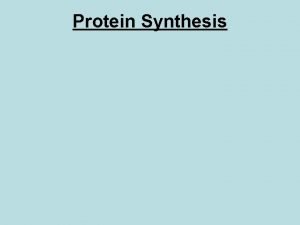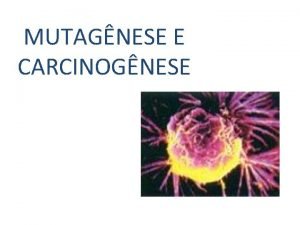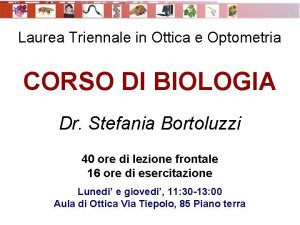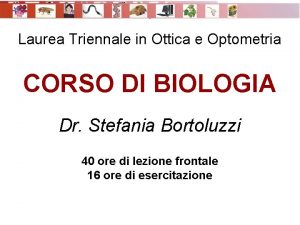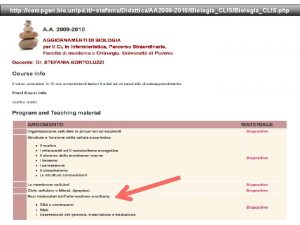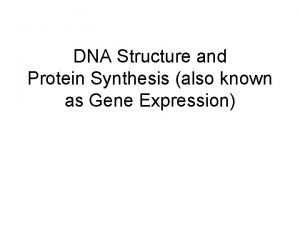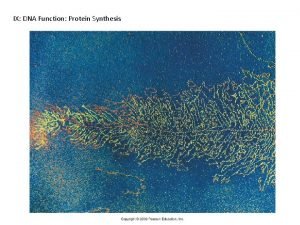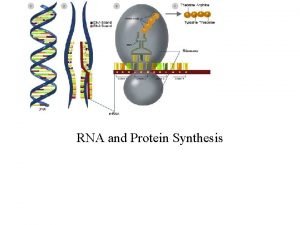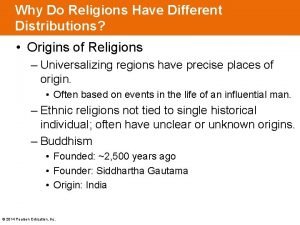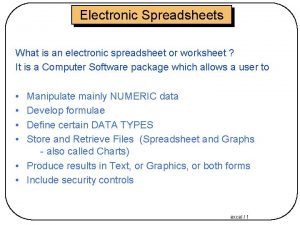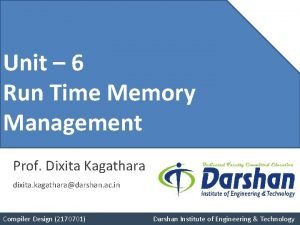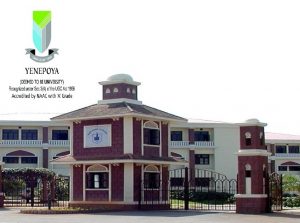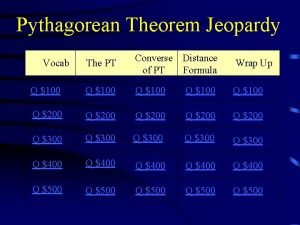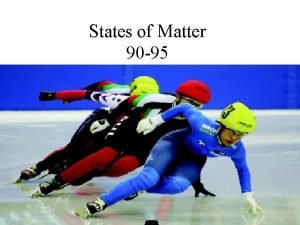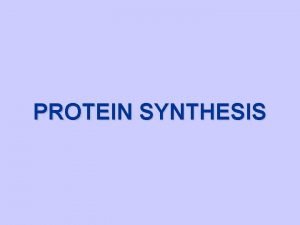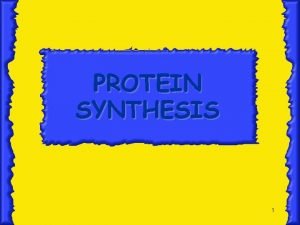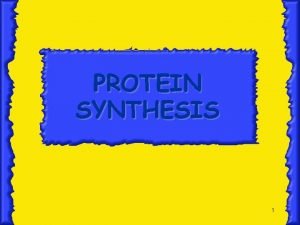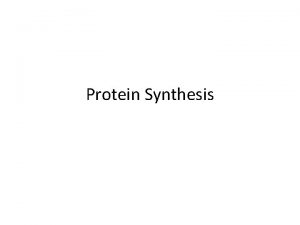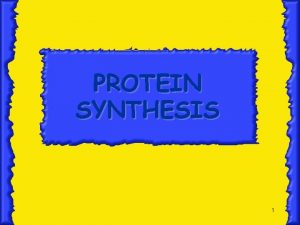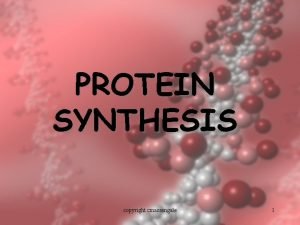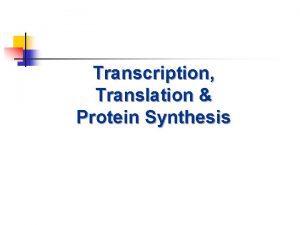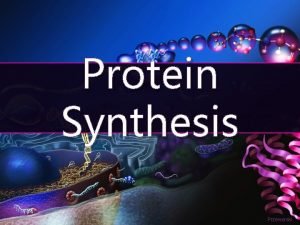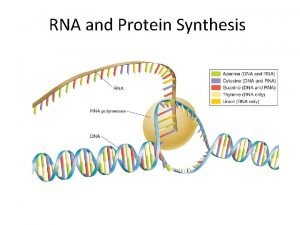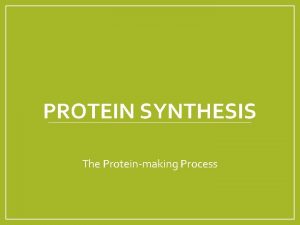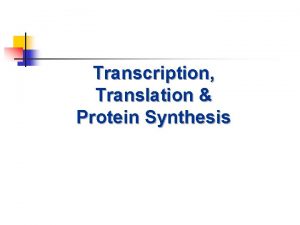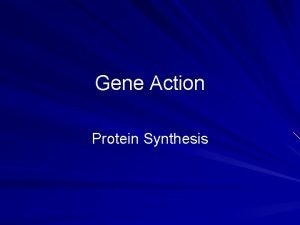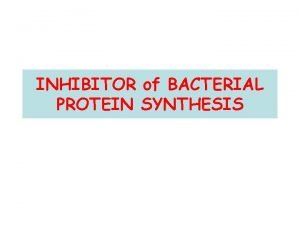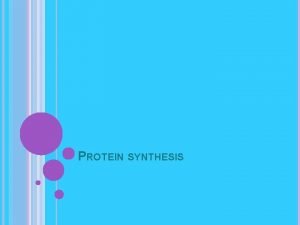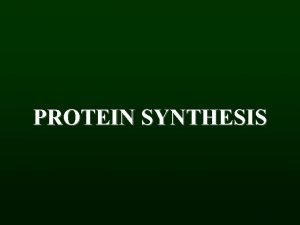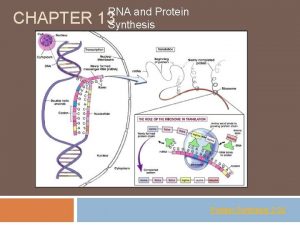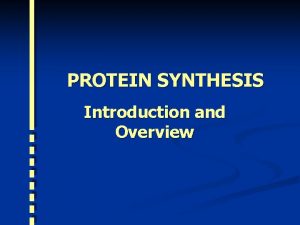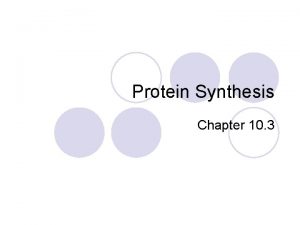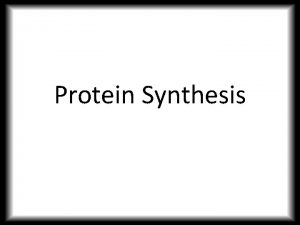Protein Synthesis 219 Explain why they have different









































































- Slides: 73

Protein Synthesis

2/19 – Explain why they have different traits.

2/19 Explain why these cats look different

Explain why these cells have different function.

Explain why your cells are all different During fetal development, different genes are turned on. This process causes different proteins to be made during transcription and translation. SO, different cells are developed. Genes being turned on and off also causes cancer.

Heritable Traits passed down from parents. All organisms if they reproduce sexually. Traits – characteristics. Maybe observable and can be not observable like personality.

DNA • • DNA is used to build RNA Genetics – study of genes Gregor Mendel – father of genetics DNA – nitrogen base order determine proteins which determines your traits • 25, 000 genes in human genome. • Human genes – they know order by the human genome project.

DNA and Genes provide instructions to make proteins 2 Stages of Protein Synthesis 1. Transcription – make m. RNA 2. Translation – read m. RNA to make protein. Proteins are made from Amino acids

Hierarchy of Life Subatomic Part Tissue Atom Organ Molecule Organ System Macromolecule Organism Organelle Cell Population Community Ecosystem Biome Biosphere

DNA controls Protein Synthesis • Cells are shaped according to their functions. • Functions are determined by the proteins. • DNA carries the message to create proteins • Which determines our traits!


NGSS Construct an explanation based on evidence for how the structure of DNA determines the structure of proteins which carry out the essential functions of life through systems of specialized cells. Ask questions to clarify relationships about the role of DNA and chromosomes in coding the instructions for characteristic traits passed from parents to offspring. QUESTION – HOW EXACTLY DOES YOUR DNA DETERMINE YOUR TRAIT?

How does DNA determine what you look like?

Central Dogma - problem Before the 1950’s, scientists knew that DNA controlled our traits but did not know how. Crick cam up with the answer. He said he solved the central problem of Biology. He called it the Central Dogma.

DOGMA! Principle, idea, or statement that is considered to be absolutely true. Kind of like a theory!!!!! But Crick called it a DOGMA!!! DNA ---- RNA ----- Proteins!!!!!! Polypeptide - protein


• DNA determines what you look like because it carries the ATCGs to make your proteins.

Protein Structure • Made up of amino acids • Polypeptide- string of amino acids • ONLY 20 amino acids are arranged in different orders to make a variety of proteins!!!! Amino acids are in the cytoplasm. • Assembled on a ribosomes • Genetic code – order of nitrogen bases

DNA vs. RNA • Double strand • Deoxyribose sugar • Adenine pairs with Thymine (A-T) • Stays in nucleus • RNA • Single strand • Ribose sugar • Uracil replaces Thymine! • Leaves nucleus to do the work

SO, HOW DOES AN AMINO ACID CHAIN GET BUILT? RNA stands for ribonucleic acid

Why make RNA? • DNA carries the nucleotide message needed to make proteins. DNA is TOO large to get out of the nucleus. You must make RNA to leave the nucleus!!


RNA There are three (3) types RNA: 1. Messenger RNA – (m. RNA) carries messages from the DNA in the nucleus to the ribosomes.

2. Transfer RNA – (t. RNA) 20 different kinds which are only able to bond with one (1) specific type of amino acid.

3. Ribosomal RNA – (r. RNA) major component (part) of the ribosome

Steps to Protein Synthesis 1. Transcription – process where DNA message is changed into m. RNA then out of nucleus to the ribosome!!! 2. Translation – process when m. RNA is translated into amino acid chains(protein) on the ribosome.


Protein Synthesis: Translation Codon – three nitrogen bases on m. RNA.


Start codons and Stop codons • For translation to begin, there is a START codon. • AUG: is the 3 letter codon that starts the process. • UAA, UGA, UAG: Stop codons.

Start Codon • Start codon: codon AUG also serves as the “initiator” codon, which starts the synthesis of a protein.

Stop Codon • STOP codon: Codon that signal the end of the protein. (UAA, UAG, & UGA • Besides selecting the amino acid methionine, the codon AUG also serves as the “initiator” codon, which starts the synthesis of a protein

DNA – TAC CGC ATC GGC ACT m. RNA – AA – DNA – TAC CGC TTC GGC ACT m. RNA – AA – DNA – TAC GCA TCG GCA CT •

Heritable Traits passed down from parents. All organisms if they reproduce sexually. Traits – characteristics. Maybe observable and can be not observable like personality.

DNA • • DNA is used to build RNA Genetics – study of genes Gregor Mendel – father of genetics DNA – nitrogen base order determine proteins which determines your traits • 25, 000 genes in human genome. • Human genes – they know order by the human genome project.

DNA and Genes provide instructions to make proteins 2 Stages of Protein Synthesis 1. Transcription – make m. RNA 2. Translation – read m. RNA to make protein. Proteins are made from Amino acids

Hierarchy of Life Subatomic Part Tissue Atom Organ Molecule Organ System Macromolecule Organism Organelle Cell Population Community Ecosystem Biome Biosphere

DNA controls Protein Synthesis • Cells are shaped according to their functions. • Functions are determined by the proteins. • DNA carries the message to create proteins • Which determines our traits!


• DON’T HAVE TO KNOW THE REST OF THIS PPT.

Step 1: • RNA polymerase complex attaches to DNA at special places that serve as the start signal(promoter sites). Only one gene!!!!!

How Does RNA polymerase(complex) know where to start and stop? • Promoter site: starting point on DNA. Specific base sequences that represents a gene. • Termination site: Place where RNA polymerase stops!!! • REMEMBER - only a gene is being read to make m. RNA not all of your DNA.

Step 2: • DNA splits at site of RNA polymerase. • RNA polymerase attaches matching bases to form new RNA strand from DNA template.

• RNA polymerase keeps adding bases making the RNA strand grow…

Step 3: • RNA polymerase leaves DNA when reaches the stop signal or termination site!!! • RNA strand is released and goes to cytoplasm. • DNA rewinds itself into the double helix.

Results of Transcription • Strand of m. RNA made from the DNA

FYI RNA polymerase doesn’t check for mistakes in the code. Doesn’t cause mutations when there is a few mistakes in proteins unlike replication.

Protein Synthesis: Transcription

Making mature m. RNA Original m. RNA transcribed is not mature m. RNA Exons: readable segments Of m. RNA that go to the ribsome Introns: nonreadable Segments that must be removed before leaving Nucleus.

Exons vs. Introns Once introns removed, m. RNA is ready to leave the nucleus!!!!

Translation is the process of decoding a m. RNA molecule into a polypeptide chain or protein. ALWAYS read m. RNA!!!!!! Three RNAs play the key roles!! OCCURS ON THE RIBOSOME!!!

m. RNA - Codons • Read 3 bases at a time on the m. RNA called CODONS!!!! • Each combination of 3 nucleotides on m. RNA is called a codon or threeletter code word. • Each codon specifies a particular amino acid that is to be placed in the polypeptide chain (protein).

t. RNA • Transfer RNA • Bound to one amino acid on one end • Anticodon on the other end complements m. RNA codon • If they do not match then the t. RNA is rejected!!!!

Parts of a Ribosomes - r. RNA Ribosomes are composed of 2 subunits separate in cytoplasm – Large – Small • Contain 3 binding sites – helps t. RNA align to codon. –E –P –A


Steps of Translation • 1. INITIATION: A. The initiator(start) codon AUG binds to the first anticodon of t. RNA at the P site signaling the start of a protein. B. Two parts of the ribosome join around the t. RNA and m. RNA. • The amino acid methionine, the codon AUG also serves as the “initiator” codon, which starts the synthesis of a protein at site P.

Translation • 2. ELONGATION: The anticodon of another t. RNA binds to the next m. RNA codon at site A, bringing the 2 nd amino acid to be placed in the protein. This will continue until stop codon. • As each anticodon & codon bind together a peptide bond forms between the two amino acids.


Protein Synthesis: Translation 3. Termination: The protein chain continues to grow until a stop codon reaches the ribosome, which results in the release of the new protein and m. RNA, completing the process of translation. The amino acids are bonded with a peptide bond to form a protein. • Release factor causes the release of t. RNA and m. RNA.




http: //staff. jccc. net/pdecell/proteinsynthesis /translation/steps. html

Summary of Translation • • Ribosome 2 parts come together. m. RNA attaches to ribosome. AUG – start codon. t. RNA brings in making anticodon with amino acid. • r. RNA continues to read m. RNA and bring in making t. RNA. *Stop codon will stop process. Peptide bonds will form to make a protein.

Translation - Initiation f. Met Large subunit E P A UAC 5’GAG. . . CU-AUG--UUC--CUU--AGU--GGU--AGA--GCU--GUA--UGA-AT GCA. . . TAAAAAA Small m. RNA subunit 3’

Translation - Elongation Polypeptide Met Phe Leu Ser Gly Arg Ribosome E P A CCA UCU 5’GAG. . . CU-AUG--UUC--CUU--AGU--GGU--AGA--GCU--GUA--UGA-AT GCA. . . TAAAAAA m. RNA 3’

Translation - Elongation Polypeptide Met Phe Leu Ser Gly Arg Aminoacyl t. RNA Ribosome E P A CCA UCU 5’GAG. . . CU-AUG--UUC--CUU--AGU--GGU--AGA--GCU--GUA--UGA-AT GCA. . . TAAAAAA m. RNA 3’

Translation - Elongation Polypeptide Met Phe Leu Ala Ser Gly Aminoacyl t. RNA Arg Ribosome E P A CGA CCA UCU 5’GAG. . . CU-AUG--UUC--CUU--AGU--GGU--AGA--GCU--GUA--UGA-AT GCA. . . TAAAAAA m. RNA 3’

Translation - Elongation Polypeptide Met Phe Leu Ser Gly Arg CA C Ribosome E Ala P A UCU CGA 5’GAG. . . CU-AUG--UUC--CUU--AGU--GGU--AGA--GCU--GUA--UGA-AT GCA. . . TAAAAAA m. RNA 3’

The Genetic Code

Protein Synthesis AMINE H H O N ACID C C ANYTHING R H Amino Acid Alanine OH H H Serine H O N C OH H C H H 2 O H H C H O C C HO N H H C O N H O C C H H HO H OH OH

Transcription And Translation In Prokaryotes ALL IN CYTOPLASM!!! 5’ 3’ 3’ 5’ RNA Pol. Ribosome m. RNA 5’ Ribosome

Transcription vs. Translation Review Transcription • Process by which genetic information encoded in DNA is copied onto messenger RNA • Occurs in the nucleus • DNA m. RNA Translation • Process by which information encoded in m. RNA is used to assemble a protein at a ribosome • Occurs on a Ribosome • m. RNA protein
 Why do different polymers have different properties
Why do different polymers have different properties Hey hey bye bye
Hey hey bye bye James tam
James tam Ap 219
Ap 219 Chapter 8 recording adjusting and closing entries
Chapter 8 recording adjusting and closing entries Spm 219 textbook notes
Spm 219 textbook notes Fra 49 cfr part 219
Fra 49 cfr part 219 Calendario lunar 219
Calendario lunar 219 What is the common situation in all these images
What is the common situation in all these images Explain skin analysis techniques
Explain skin analysis techniques What is cultural relativism
What is cultural relativism Manufactured boards examples
Manufactured boards examples If we'd seen you we (stop)
If we'd seen you we (stop) Flame test principle
Flame test principle Totipotent cell
Totipotent cell Section 12 3 rna and protein synthesis answers
Section 12 3 rna and protein synthesis answers Messenger rna codons
Messenger rna codons Dna replication
Dna replication Translation
Translation Transcription and translation bbc bitesize
Transcription and translation bbc bitesize Protein synthesis and mutations
Protein synthesis and mutations Protein synthesis cookie analogy
Protein synthesis cookie analogy Whats the central dogma of biology
Whats the central dogma of biology Dna and rna
Dna and rna Protein synthesis
Protein synthesis Protein synthesis
Protein synthesis Protein synthesis and mutations
Protein synthesis and mutations Dna rna and protein synthesis study guide
Dna rna and protein synthesis study guide Synthesis
Synthesis Protein synthesis and mutations
Protein synthesis and mutations Protein synthesis animation mcgraw hill
Protein synthesis animation mcgraw hill Test cross definition
Test cross definition Translation protein synthesis
Translation protein synthesis Ribonucleic acid
Ribonucleic acid Protein synthesis
Protein synthesis Protein synthesis ppt
Protein synthesis ppt Picture of protein synthesis
Picture of protein synthesis Protein synthesis inhibitor
Protein synthesis inhibitor Which best summarizes the process of protein synthesis?
Which best summarizes the process of protein synthesis? Concept map of protein synthesis
Concept map of protein synthesis Protein synthesis
Protein synthesis Protein synthesis scramble
Protein synthesis scramble Steps of protein synthesis
Steps of protein synthesis Cytosio
Cytosio Protein synthesis
Protein synthesis Sintese de proteinas na celula
Sintese de proteinas na celula Protein synthesis
Protein synthesis Protein synthesis
Protein synthesis Protein synthesis
Protein synthesis Protein synthesis
Protein synthesis Dna rna venn diagram
Dna rna venn diagram Dna rna protein synthesis homework #2 dna replication
Dna rna protein synthesis homework #2 dna replication Rna transfer
Rna transfer Protein pump vs protein channel
Protein pump vs protein channel Protein-protein docking
Protein-protein docking Reasons why community problems have to be analyzed
Reasons why community problems have to be analyzed Why do religions have different distributions
Why do religions have different distributions Why do plants have different parts
Why do plants have different parts Why do plants have different parts
Why do plants have different parts 6 faces 12 edges 8 corners
6 faces 12 edges 8 corners Don't ask why why why
Don't ask why why why What is meant by modifiers of human acts
What is meant by modifiers of human acts What is an electronic spreadsheet?
What is an electronic spreadsheet? List and explain different subdivisions of run-time memory
List and explain different subdivisions of run-time memory What is micro teaching
What is micro teaching Sound will travel at different speeds in different mediums.
Sound will travel at different speeds in different mediums. Library thinkquest org 19537
Library thinkquest org 19537 Different angle different story
Different angle different story Different faces song
Different faces song Things that make us different
Things that make us different Venn diagram different same different
Venn diagram different same different Keelie has a triangular shaped card
Keelie has a triangular shaped card How are they different
How are they different Rankings: what are they and do they matter?
Rankings: what are they and do they matter?


